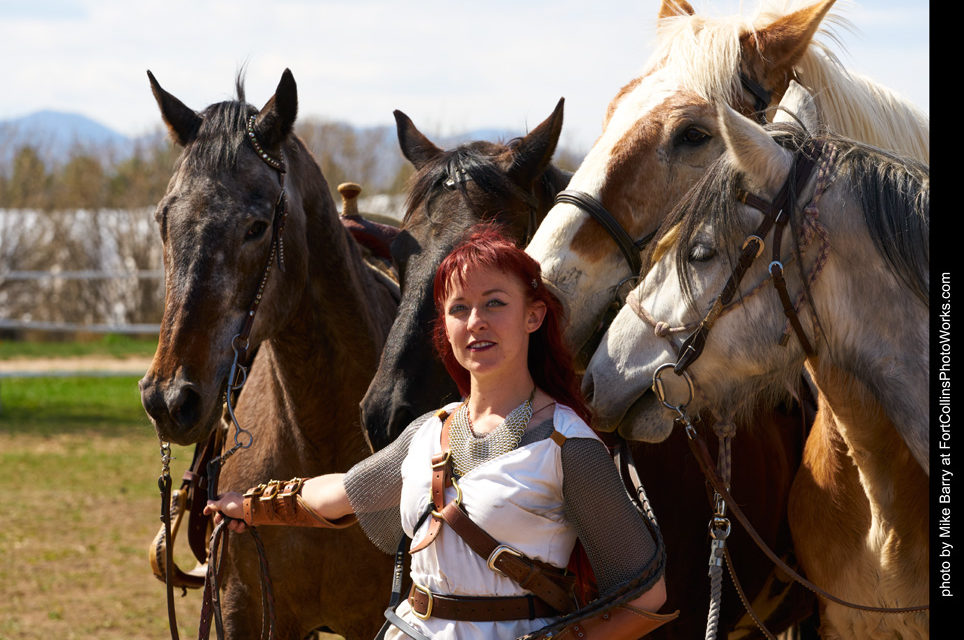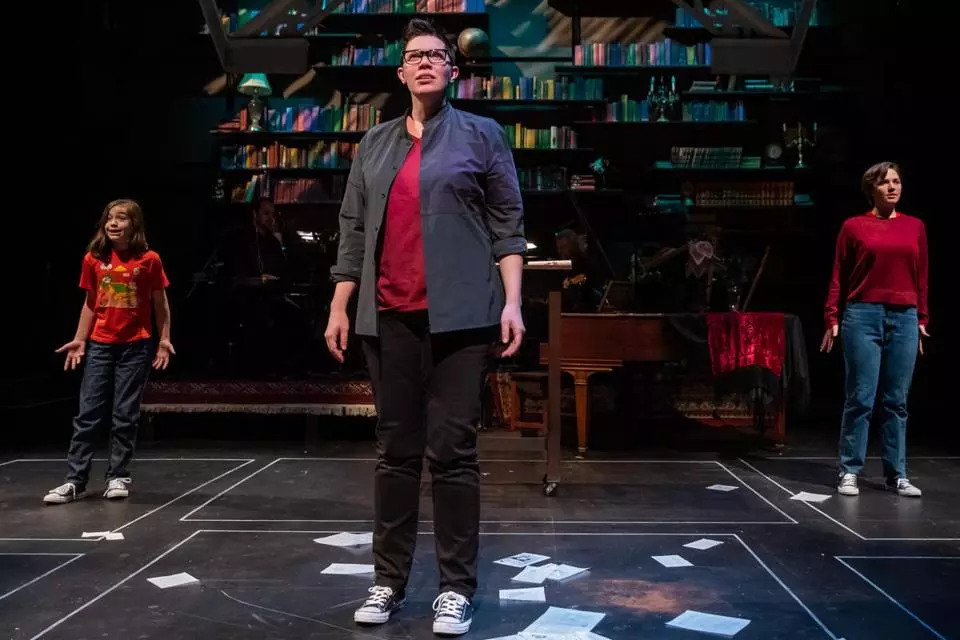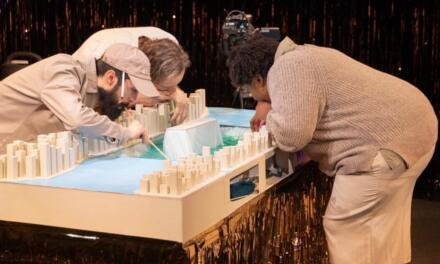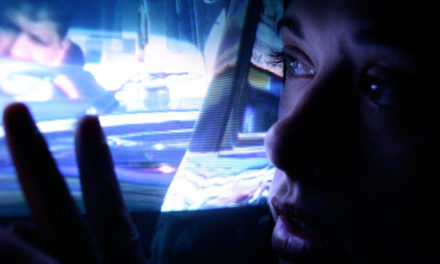Kryssi Jeaux Miller is a young woman full of surprises. Kryssi wears many hats: she performs, produces, manages artistic works of many genres, takes risks, and persists in a truly exemplary fashion. A Colorado State University graduate (Theatre and Psychology, magna cum laude), and an artist with an extensive acting resume, Kryssi Jeaux Miller also writes and performs music, paints, directs, and teaches horseback riding. As of 2016, she is also the founder and the Captain of the Knights of the Tempest, a Colorado-based jousting troupe with a patriarchy-smashing agenda. Since 2018 Kryssi is the owner of Laughing Wolf Ranch in Colorado, US, where she devotes most of her time to training her creatures, building horse tack and other jousting equipment, envisioning the future of live, combat-filled equestrian theatre, and teaching high school English.
I.Yakubovskaya: How did professional jousting end up as your main occupation?
K. Miller: It is the one activity I’ve found on this planet so far that makes me happy all the time. I love contact sports, and jousting is the most thrilling I’ve come across. As someone who willingly put in the time and effort to invest in the horses, training, and equipment, it is completely addictive. I love leatherworking, leather carving, and building saddles, bridles, and other tacks my horses wear in the show, on film, and for other events. My troupe and I build the medieval training equipment we use in our live performances and when we train for competitive jousting tournaments. The people who are associated with the sport of competitive jousting are terrific. We all share the same insanity and passion for this amazing phenomenon.
I.Yakubovskaya: Why did you choose Knights of the Tempest as the name of your troupe?
K. Miller: Two major things—this is a troupe that was started by a group of really intense performers who love this style of theatre. This troupe was born out of tempestuous circumstances. We overcame a lot of chaos to band together to create something even stronger and more exciting. It’s also a tip of the hat to Shakespeare’s The Tempest, because most of us in the troupe are big-time readers and writers, and live theatre has always been a passion of mine, and you don’t really get way more popular in the realm of live-theatre tradition than Shakespeare. I always dreamed of being a part of a traveling theatre troupe, in a brightly painted wooden wagon pulled by Gypsy Drum Horses. I never really imagined having to run the whole thing, but the kind of characters I wanted to play really didn’t exist yet, so I decided to make my own.
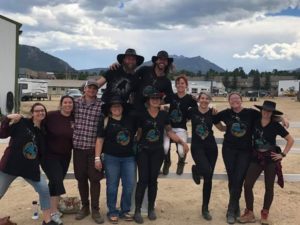
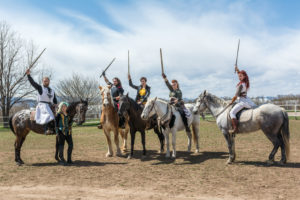
We [Miller and her cast mates] were all professional medieval-style and Renaissance jousting performers. Then I started the troupe driven by the goal of smashing the patriarchy. To me, it is not about an all-female troupe that excludes men, but more about equality and representation. The stories are set in an alternate universe where there was never a question about whether women and men were equal. That’s my favorite approach to gender equality.
I see empowering women as the main objective of all my productions. I want young girls to see these shows where amazing female warriors do not seem weird or out of place. I want women of every age to get pumped, jump on a horse, fire arrows, be loud, take up space. If you train hard enough you can be better. You can become comfortable with being in the spotlight. Another thing is—little boys should know that they can have role models that are women. At one Renaissance fair, a young boy and a girl came right up to me after a show. I immediately gave the girl a huge hug but paused before hugging the boy. It was a valuable moment of self-reflection. I started thinking about how little boys are not usually brought up to look up to women.
I. Yakubovskaya: How does your work differ from a traditional “medieval theatre troupe” or “jousting troupe”? What type of jousting do you do?
K. Miller: We race our horses at each other and smash into each other’s shields as hard as we can. The jousting tournaments we do in our live performances are real, in that the actors and the characters they play are both actually trying to break more lances more spectacularly on the other’s shield.
I. Yakubovskaya: Historically, jousting is a medieval practice. Are the scripts based on real-life history, and how exactly medieval are they?
K. Miller: The stories are character-based scripts with a patriarchy-smashing agenda. The shows are created based around the layered characters our actors are constantly developing, as well as the particular line-up of stunts we want to put into the show. I grew up performing in Wild West shows with my Appaloosa horse, Cherokee (who turns 29 in March), so I love creating a great live show that has audiences entertained. I have a passion for bullwhip tricks and stunts, archery, knife throwing, combat, and stunt falls—anything that takes a lifetime of education and an insane amount of practice to get good at. Because that’s what I want to impress people in the shows. I want people to see things they have never seen performed live before. Or performed ever. And humor. I love to laugh. I want the audience to laugh.
The shows are funny. Our last show featured jokes being exchanged while a male and female character were physically fighting. The characters are dynamic. Thorvald, for example, is a male character who starts out as a satirical version of societally conditioned toxic masculinity. In the beginning, he kidnaps Aerin, assuming she is a princess. However, Aerin turns out to be a powerful warrior, so she proves his expectations wrong. Thorvald gains respect for his female counterpart and discovers that he loves her for who she is.
I. Yakubovskaya: How timely do you find female-driven storytelling and subverting the master narrative of patriarchal tropes? Do you receive surprising audience reactions to some of the stories’ elements, like the unstoppable female warriors and leaders?
K. Miller: This is very important to me. I wanted to create a character I wanted to play [Kryssi plays Aerin, the Knight-Captain of the kingdom’s cavalry and white knight of the show]. The other members of the troupe are this way as well. Everyone puts a lot of detail and effort into developing their characters. In the troupe, we have a cavalry knight captain, a Viking, a wandering folklorist, battle-torn knights, and a shieldmaiden. Alright, that last one is in the title, but three of those other [traditionally male] characters are played by females. We don’t make a huge deal in the show about four out of six of our show’s characters being female. They just are. I don’t put a ton of effort into being historically accurate, although we as Knights of the Tempest do love continually educating ourselves about historical medieval combat and weaponry. The world of our script is one where things are different. We created a world where women and men were always equal. Our fight choreography is realistic, too. Our male knights are massive, but they do not pull their punches. Each character is constantly developing a fighting style effective for each actor’s unique physical build as well as their character’s style and background training. The troupe members have many things in common, but you have never seen such a wellspring for creativity. When we get together to brainstorm, a million different ideas come up, with a million more different ways to execute them. I found a group of people who share a burning passion for outdoor live street theatre involving giant prey animals who can adapt and support each other no matter what.
I. Yakubovskaya: What interests you in street theatre as a genre?
K. Miller: I have always been enamored of street theatre. I first was amazed by it as an art form while walking down the Pearl Street Mall in Boulder, Colorado, as a young child. I’d watch a man dislocate his own limbs to fit inside a small plexiglass box. Amazing things you can watch for free, just a few feet away. I am constantly impressed by the tenacity and charisma of street performers. I literally fell in love with a street performer eight years ago [Kryssi Miller’s long-term partner in crime is an acrobatic juggler turned jouster, Bryan Circus Knight]. As an art form, street theatre requires such a heavy dose of grit, charm, and bravery that really makes it stand apart from other, “safer” forms of theatre in playhouses. It’s transient, it’s improvisational, it’s real and dangerous in a way that I adore.
I. Yakubovskaya: You have been involved in the local circus community for some time now. How does your experience in circus inform your current work?
K. Miller: I love the creativity possible in the circus. It’s artistic, and magical, and uses the bodies and makeup and costumes and music to captivate the audience. It’s close, collaborative work with good friends and creative geniuses. I just want to add animals and weapons into the mix.
I. Yakubovskaya: Apropos of animals, some of the biggest circus companies have recently begun excluding animals from their programming. I don’t imagine you support the return of animal exploitation in circuses (and elsewhere), so how do you envision animals becoming integral parts of the circus?
K. Miller: No, I do not support animal exploitation. In my world, animals are fellow actors. They’re characters in the show. It’s a nice thing about writing our own shows. The small, local scale of my company allows me to oversee everything in detail, so the quality control is meticulous. We are writing the shows around the animals I have available. Many animals are older and rescues; it’s an eclectic mix. I work with these animals, I know them well. For example, one of the horses in the show was a rescue, and would nod his head anytime we high-fived. As a result, we write the scenes around their mannerisms to incorporate the animal behavior organically rather than forcing them to perform. All the animals must be calm, but there are animals who get switched on easily in a live performance. For example, my trick horses are highly intelligent and tend to get themselves into trouble if they aren’t stimulated or challenged enough. Just like with human actors, there are divas and ol’ reliables among my animal performers.
I. Yakubovskaya: Seeing your show is like watching a superhero movie in real life. Do you think it inspires people more to see the difficult performances in person and done by someone who is a real local person, as opposed to a CGI-ed movie star on a screen?
K. Miller: I will always advocate for live performances. I crave the electric exchange between performer and audience in a live show. The modern-day superhero movies are too long and amped up for me, and the larger-than-life CGI elements lose my interest. I want to be blown away by watching real characters (human or animal) interact onstage, showing off skills and bonds it’s taken years to develop. And when those real people and animals can do incredible stunts, show after show? Even better.
I. Yakubovskaya: As a theatre major and an active local theatre artist, you probably thought about what most young college-grad actors think about: whether to move away or not. How did you decide to stay in northern Colorado to keep contributing to the local culture? Was it a difficult decision?
K. Miller: I first really started to invest in theatre in high school. I planned to go to NYU and be Elphaba in Wicked on Broadway. My senior year of college as a theatre major at Colorado State University I was planning to move to LA with my friends to pursue a career in film. After taking a course taught by a film actor who had found moderate success in LA, however, I had a change of heart. I didn’t want to strike it rich by landing a famous fast-food-chain commercial. Not to mention the hellscape I pondered in moving my animals. LA living would probably have led me to own fewer warhorses and hounds, not more. A three-week trip to study live theatre in London further confirmed my addiction/devotion to live, wonderfully ephemeral theatre. I watched Benedick from Much Ado improvise as a helicopter loudly flew overhead during one of his monologues at the Globe Theatre. Watching his incredulous, sweat-covered face break into a laugh that he shared with the audience as he regained our mutual footing in an age of theatre long-past was a special moment I wanted to create on my own from that point on. I would rather be famous on a small scale, working with my close friends in my favorite place on Earth, than making bags of cash saying a few lines selling fast food on TV.
I. Yakubovskaya: Since we first talked about the possibility of this interview, you’ve metamorphosized from an educator, producer, and performer into a businesswoman who trains horses on her own ranch. How does it feel to be starting this new chapter in your career?
K. Miller: I am just trying to keep up. I am drowning in animals, and honestly, they are all athletic, expressive, and highly intelligent, because these make for great performers. However, trying to keep them all stimulated, well-worked, and entertained while teaching full time is exhausting [Kryssi teaches English and language arts courses at a rural high school]. It leaves very little time and energy (and definitely money) for anything else. But even more than that, I am ecstatic. Every day I am living my dream. I always want to get further, of course. But I have a ranch where I can walk outside and see the stars and pet my horse noses any time I please when I’m not at the school. It was the necessary step toward the next growth phase for the Knights of the Tempest, and I cannot wait to see what this year brings. The main rewards are that my friends and I can create whatever we want. I get to collaborate with the smartest, strongest, most inventive and supportive people in the galaxy. I get to play around with beautiful, clever, dangerous beasts. The only limit is the boundary of imagination. The challenges are boring predictable things like money and time and naysayers. Obviously, the pros greatly outweigh the cons.
This post was written by the author in their personal capacity.The opinions expressed in this article are the author’s own and do not reflect the view of The Theatre Times, their staff or collaborators.
This post was written by Irina Yakubovskaya.
The views expressed here belong to the author and do not necessarily reflect our views and opinions.

